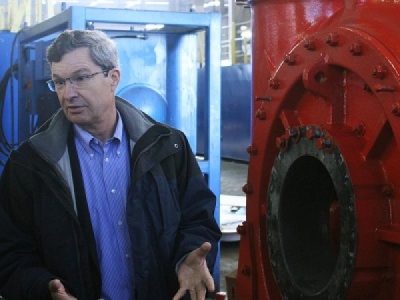
Posted on February 20, 2018
By Maria Sieron, Baltimore Business Journal
At Ellicott Dredges’ southwest Baltimore facility, a variety of dredging equipment in the company’s signature red, white and blue colors are ready to be shipped across the world.
Since the company’s start in 1885, Ellicott Dredges has designed and manufactured over 2,000 dredges for customers in over 100 countries — including all of the dredges used in the original construction of the Panama Canal in the early 1900s, giving the company an internationally known brand name.
More than half of Ellicott Dredges’ sales are exported, a figure CEO Peter Bowe says makes the company’s “jobs dependent on exports.”
Today, the manufacturing industry contributes a record $2.25 trillion to the U.S. economy, employs more than 12 million workers and has the largest economic impact of any major sector, according to a recent report by the National Association of Manufacturers.
Recent growth in the sector comes in large part from regulatory reforms and tax cuts made under the Trump administration, the association reported.
In Maryland, 3,700 manufacturers employ 106,800 workers, or 4 percent of the state’s workforce, according to the National Association Manufacturers. The workers had an average annual compensation of about $85,000 in 2016.
“While the manufacturing industry in Maryland is relatively small, it is very active,” Bowe said.
Maryland’s location is advantageous for manufacturing and distribution. In the middle of the East Coast, next door to Washington D.C., and close to several international airports, the state is set in one of the nation’s busiest commercial corridors. And with the Port of Baltimore, manufacturers such as Ellicott Dredges, experience additional ease in exporting products.
If you’re not familiar, dredging equipment is built and designed for sand mining, harbor and navigation maintenance, water reservoir restoration, river and channel dredging, beach restoration and erosion control, and environmental clean-ups, among other applications. To put it simply, the dredges function as “floating bulldozers” or “floating vacuums,” Bowe said.
The company recently built three dredges at its Carroll-Camden industrial area facility: A standard model dredge heading to Bangladesh to help with flood control and navigation; One to dredge sand at a golf course in Canada; and a dredge designed to mine salt for a Saudi Arabian chemical company.
The price of a dredge ranges from a few hundred thousand dollars to about $30 million.
While the majority of sales are exported, Ellicott Dredges, and manufacturing companies such as his own, rely on vendor chains for parts and components from other suppliers. “We buy from companies all over the country and sometimes around the world,” Bowe said.
Employees at Ellicott Dredges reflect its connection to the global economy as well. The company employs 125 at its Baltimore factory — one of four worldwide — and 250 people companywide. About 10 percent of its U.S. employees were born overseas, Bowe said.
As 2017 came to a close, the company had orders for over a dozen dredges from six continents.
“Business is steady and opportunity for growth comes from new products, applications and export markets,” he said.
Source: Baltimore Business Journal





